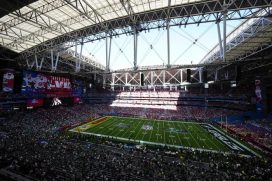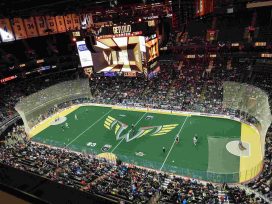This is Part II of a two-series breaking down Marcus Mariota. For those of you that missed it, Part I details how Mariota went from a backup quarterback on his high school football team to the Heisman trophy winner and potential top-5 pick in the NFL Draft. Part II turns to the tape and scouting reports to see if Mariota's game will translate to the NFL.
Marcus Mariota is one of the most polarizing prospects in this draft. Some, including Tony Dungy, have compared Mariota to Aaron Rodgers.
Others see a "system quarterback" that is going to need time to adjust to "pro style offenses" before he can meaningfully contribute in the league. Pull up any scouting report on Mariota and you will likely see the following (per WalterFootball.com):
Weaknesses:
- Pocket passing must improve
- Rarely threw into tight windows
- Ball placement needs to get better
- Played in a college system, not a pro-style offense
- Can look to run too quickly when his first read is covered
- Must improve footwork
- Fumbles the ball regularly
- Will need practice working under center
- Could use more beef on his frame to help durability
Some of these concerns are valid. Mariota's tape shows that he can sail throws when he is not under pressure, that he needs to improve his pocket awareness, and that he struggles with fumbling the football.
But some of these concerns seem to be a byproduct of group think: listen to Mel Kiper, Jr., Todd McShay, or Mike Mayock, and you will invariably hear that Mariota did not play in a pro style offense, needs to learn how to operate from under center, and has to prove that he can make the requisite NFL throws. Next thing you know, the criticisms are regurgitated on ESPN and NFL Network like political talking points, regardless of whether the experts actually studied the film for confirmation.
Jon Gruden alluded to this point in an article published on ESPN this week:
I don't understand why [Mariota] isn't the No. 1 player in this draft on Mel Kiper's Big Board. I don't know anybody in this draft that can do for a football team what Mariota can do. He can read the field. That whole thing about Oregon being a no-huddle, dive-option team, that is just a narrative resulting from a lack of information. The Ducks run a lot of pro-style concepts. Mariota does a lot with the protections. I've seen him throw the ball with touch and timing in tight windows.
Mariota is the same size as James Winston. He runs 4.52 40, he is incredibly elusive, and man, is he a playmaker and a great competitor. I see him functioning in the pocket, out of the pocket, and if you want to run a zone-read, he'll rip the defense apart. He is like Russell Wilson, only he is 6-4.
Other concerns seem to be rooted in an inherent skepticism of NFL scouts and executives who assume that a quarterback running the spread offense cannot adjust to a "pro-style offense" without considerable growing pains. This skepticism is understandable. The significant majority of the spread option quarterbacks that preceded Mariota have largely validated these concerns: Robert Griffin, III, started strong but proved that he could not succeed if you took away his mobility. Cam Newton has shown signs of being a functional NFL quarterback, but his passing numbers are still largely average. Tim Tebow, well, his lack of success in the NFL does not need much explanation.
These quarterbacks were derided for their lack of "pro readiness" in comparisons to their more traditional counterparts like Andrew Luck. And by in large, those criticisms turned out to be true. But while the lack of production from other spread quarterbacks justifies the skepticism of Mariota to an extent, it should not completely overshadow the considerable talents that he brings to the table.
Let's take this out of the abstract and get to the tape. Because as they say, "The tape don't lie." I broke down Mariota's tape focusing on five key areas: (1) Accuracy; (2) Reading a defense; (3) work ethic; (4) arm strength; and (5) pocket mobility.
Functional Athleticism
I wanted to start here with Mariota because there seems to be a fundamental misconception about his game. He is often lumped in with other read option/spread quarterbacks that ran the ball at a high clip in college. It's why you here scouts/experts suggest that Mariota runs too quickly at the first sign of trouble.
However, neither the stats nor the tape back up this assertion. First, let's look at the rushing attempts per game of the more notable quarterbacks to come out as of late. Note that I only included statistics for when each quarterback was the full-time starter.
|
Player |
Runs/Game |
|
Cam Newton |
18.85 |
|
Tim Tebow |
14.70 |
|
RGIII |
12.87 |
|
Colin Kaepernick |
11.76 |
|
Russell Wilson |
8.82 |
|
Marcus Mariota |
8.21 |
|
Jameis Winston |
5.37 |
|
Andrew Luck |
4.28 |
You can see that Mariota ranked third lowest in rush attempts per game among his contemporaries. His 8.82 rush attempts/game are less than half that of Cam Newton, and approximately 40% less than Tim Tebow. But he also ran considerably less than Robert Griffin and Colin Kaepernick, two prospects to whom Mariota is most often compared by his skeptics.
The tape validates these numbers. It does not show a quarterback that runs at the first hint of trouble as some suggested. More often than not, Mariota eschewed running for a first down and instead used his athleticism to extend plays so that his receivers down field could get open.
Here are a few such examples:
This is just a great job of extending the play against Arizona. Notice how he does not take off to run, but instead keeps his eyes down field looking to make a play.
This play reminds me of Aaron Rodgers and Ben Rothleisberger, who are masters at extending plays behind the line of scrimmage. The ability to not only escape pressure but then have the wherewithal to flick the ball to the running back for the first down is very impressive.
Finally, check out this play against FSU. Mariota is able to extend the play and throw a strike to a receiver on the run. Again, look at his eye level; he never drops his head to look at the oncoming pass rush.
To be sure, Mariota is a very good athlete, and he has the ability to use his legs to get a first down. It's why you see plays like this:
Mariota will make plays like this when he has to. But as we see, the majority of the time he is using his athleticism to extend plays so his receivers can get open downfield. We have seen Aaron Rodgers, Big Ben, Russell Wilson and Tony Romo use this to great success in the league. Mariota should be able to do the same.
Accuracy
When Chip Kelly first came to the Eagles, there were a lot of misconceptions about his offense. Many thought he had to have a mobile quarterback and that the passing game was based almost exclusively off bubble screens and short passes. After watching it for two years, I think we can all agree that this assumption was off base.
I bring this up because many experts criticize Mariota's game — and his ability to throw accurately from the pocket — based on a misperception that Mariota is not required to make "NFL style throws."
When I watched the tape, I saw a quarterback that consistently attacked the defense down the field. Unlike Brett Hundley, who relied primarily on his running ability and bubble screens, Mariota was consistently throwing those intermediate to deep routes in Oregon's offense. And he did so with timing, touch and accuracy.
Profootballfocus.com has a great comparison between Mariota and presumptive number one pick Jameis Winston by the numbers. You should definitely check it out. But one thing that stuck out to me was how often, and how effective, Mariota was on throws of 10+ yards that were NFL style throws:
While he threw a lot of wide receiver and tight end screens, he also threw a lot of NFL style throws: out routes, post routes, go routes, and crossing routes. Also notice that his per throw average and quarterback ratings on those throws were encouraging: out routes (8.6/114.2); post (19.8/147.5); go (22.8/119.9); and crossing routes (11.8/120.5).
Once again, the tape backs up these numbers. Take for example this great back shoulder throw from Mariota for 30+ yards:
Or this throw against Arizona, where he stands tall in the pocket, gets through his progressions, and delivers an accurate ball with the right amount of touch to a receiver covered by two defenders:
However, at times, Mariota struggles to throw the ball with accuracy from the pocket. This is largely the result of his mechanics, but they seem correctible:
Mental Aspects
By mental aspects I mean the ability to read a defense prior to the snap, making the necessary adjustments, and going through his progressions. It is a critical skill for an NFL quarterback. You don't need to be Peyton Manning to be successful, but you do need to be better than Michael Vick.
I tried to highlight above the instances where we saw Mariota go through his progressions. It's why I think the criticisms of his game in that respect are largely overblown, such as the oft-cited claim that Mariota threw to his first read 90% of the time in college. The tape simply does not back this assertion up.
Watch Mariota go through his progressions here, using his eyes to look of the safety, and throw a 20-yard post on a rope to a receiver in stride.
One of the biggest concerns with Mariota is his pocket awareness. While we saw several examples above of Mariota being able to avoid pressure within the pocket, there are other plays where he lacks pocket awareness. While this has not manifested in interceptions, he does have a fumbling issue. Take this play against Ohio State in the National Championship Game for example:
Mariota is going to need to improve in this area if he is going to succeed at the next level.
Work Ethic
I covered Mariota's work ethic in Part I. This tends to be a gray area for coaches and scouts during the draft process. College coaches have a vested interest in their players making it to the next level so they can use it as a selling point on the recruiting trail. While coaches will not outright lie for a lazy player, they will usually stretch the truth if they think it will help the player (and by extension, the coach) out.
Mariota's work ethic is well-known. And while some of it might be the result of hyperbole, the uncertainty is largely removed from the equation because Chip Kelly coached Mariota. So he knows the time that he puts in to hone his craft. This should not be an issue.
Arm Strength
Finally, no one will mistake Mariota's arm strength for Jay Cutler or Joe Flacco. But his arm strength is more than adequate to make all of the NFL throws.
Here is a great example of his arm strength, ability to move within the pocket, and scan the field for an open receiver. The only problem? The receiver just drops the ball; but that certainly cannot be held against Mariota:
Here is another example of Mariota's arm strength on display. He moves within the pocket and delivers a strike between two defenders.
Overall: Mariota's game is not without fault. He needs to improve his pocket accuracy, brush up on his mechanics, and fix his fumbling issues. But the concerns about his NFL readiness seem to be largely the result of a misunderstanding of what he was required to do at Oregon.
Mariota is a great athlete, but more often than not will use that athleticism to extend plays for shots down field instead of taking off for a run. His pocket mobility, intelligence, work ethic and accuracy validate the Aaron Rodgers and Russell Wilson comparisons.
While I think he will likely be successful in most offensive systems, he could be truly special if the Eagles can somehow land him. Here's hoping they do.
Patrick Causey is a writer at Eagledelphia.com and can be followed on Twitter @PhillySportsJD







